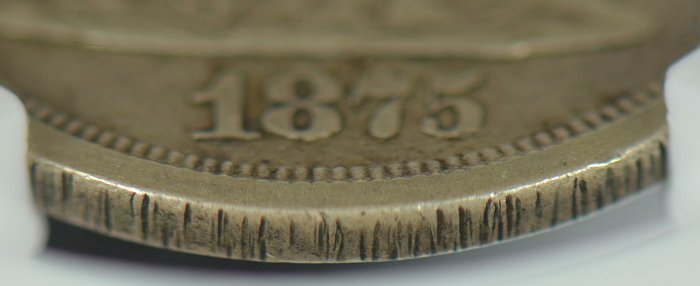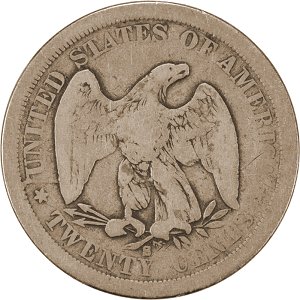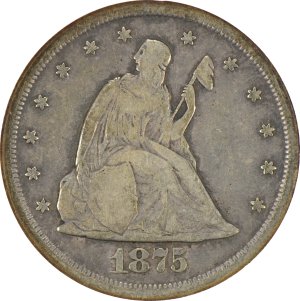5 Grading
The obverse of the United States twenty-cent piece is similar to that of the dime, quarter dollar, and half dollar struck in the same years. The coin depicts Miss Liberty sitting on a rock with her
body facing to her left and her head turned to the right. In her left hand is held a pole with a liberty cap. Her right arm is at her side supporting a shield onto which the word LIBERTY is inscribed.
Surrounding the periphery of the coin are thirteen stars, seven to her right and six to her left. Pointing from the rim to the center of the coin are a series of small raised denticles. Centered
beneath the rock is the date.
The reverse of the coin is similar to the reverse of the United States Trade dollar. The eagle is posed with wings spread and head facing to its left. In its right talon is clutched a group of
three arrows and in the left talon is an olive branch. Around the periphery of the coin are the words UNITED STATES OF AMERICA in an arc above and to the sides of the eagle. Beneath the eagleís
legs are the words TWENTY CENTS. Separating the phrases are two individual stars. Centered beneath the talons, below the intersection of the arrow feathers and stem of the olive branch, is where
the mintmark is found. Coins minted at San Francisco carry the ĎSí mintmark and those minted in Carson City bear the ĎCCí mintmark. Coins from the Philadelphia Mint have no mintmark.
When grading this series, as well as many of the other United States series, emphasis is placed on the obverse of the coin. Interestingly, many twenty-cent pieces have a split grade. That is, the
obverse is a different grade than the reverse. Usually the reverse grade is higher, sometimes as much as a full qualitative grade. The coinís reverse is fairly undulating, and has a lot of relief
in several areas. The eagleís breast and the ends of the wings are much higher than the surrounding areas, with concavity in between, thus offering protection from wear for the rest of the feathers.
A higher reverse grade should be given strong consideration when determining the coinís final grade. If the opposite is true and the reverse has a lower grade than the obverse, then the lower grade
should be considered when assigning the coinís overall grade.
Special note should be taken with coins struck in Carson City, as LIBERTY on the shield is often weak on the obverse as well as the eagleís right wing on the reverse. While more common on Carson City
coins, the weakness is also known on coins from San Francisco and Philadelphia. This weakness is due to the coin receiving a softer strike resulting in decreased metal flow into these areas of the coin.
The decreased metal flow occurs as Libertyís shield and the eagleís right wing together are the deepest recesses in the dies and hence the last to be filled by the planchetís metal as the coin is being struck.
In many grading guides, counting the letters in LIBERTY on the obverse shield is used as a shorthand method to quickly grade twenty-cent pieces. This follows the approach often used for other coins in
the Liberty Seated series as well some other coins like Indian Head cents and Liberty Head nickels. For those series, a full LIBERTY is a primary determinant of a coin grading at least fine. LIBERTY
is incuse and thus wears fairly predictably relative to the rest of the coin. This simply isnít the case for double dimes.
For twenty-cent pieces, many grading guides indicate that a full LIBERTY is needed for a coin to grade at least very fine. This difference is due to the nature of the design on the obverse because
LIBERTY is in relief (raised) on double dimes. Since LIBERTY is in relief, it tends to wear away much more quickly than on other Liberty Seated coins where LIBERTY is incuse and thus a full LIBERTY
would indicate a coin of higher grade when compared with a similar coin from a different denomination in the Liberty Seated series. While that approach is reasonable, it does not account for the
inherent weakness in the shield found on many twenty-cent pieces. Thus, collectors should grade a double dime based on the entire coin, and not focusing on one specific area of potential wear.
Another common area of design weakness is on the reverse in the area around CENTS. Whether due to debris in the die during striking or another area of poor metal flow, CENTS is commonly weak even
on specimens in middle to higher grades.
There is one more important thing to note about grading, which applies to all coins. One should always examine the edge of the coin, looking for edge cuts or repairs. These would have a negative
impact on the coinís value, and should be noted. Some coins had their edge hand-reeded by carving numerous cuts into it, likely to attempt passing them as quarters. There even exists a certified
and graded twenty-cent piece with a crudely reeded edge that somehow escaped notice.

1875-S twenty-cent piece with a crudely reeded edge
The following pages provide grading descriptions and photos for circulated coins, along with a diagram with initial points of wear to help determine uncirculated coins from examples with the
slightest amount of friction or wear. The descriptions below use the widely adopted Sheldon numerical system of grading that assigns numbers from 1 to 70 as part of the grade (with 60 and
above representing mint state examples).
Good (G)
![]()


G-4
Obverse
![]()
The entire design is well worn with little detail remaining. The shield will be weak but discernible in places. Most often the
lower point of the shield will be visible. The stars will be flat with no centriles. The denticles are worn into the rim,
but there will be a full rim.
![]()
Reverse
![]()
The eagle will be well worn, but will remain outlined. A few of the feathers will show. The head and breast will be nearly
smooth. The denticles are worn into the rim, but there will be a full rim.
Very Good (VG)


VG-8
Obverse
![]()
The entire design is worn with some detail remaining. Detail remains in the gown, but the knee and legs are worn smooth or nearly so.
Detail in the gown can be seen under Libertyís right arm. Some detail in the shield may be visible with most of the shieldís
outline visible. One or two letters in LIBERTY may be visible. The stars will be flat but an occasional centrile may be visible.
The denticles are starting to wear into the rim.
![]()
Reverse
![]()
The eagle is worn with less than half of the feathers showing in the wings and legs. The center of the breast is worn smooth.
The eye is very weak or may not be present. The denticles are beginning to wear into the rim.
Fine (F)


F-12
Obverse
![]()
The design is moderately worn but the entire design is clear. Detail remains in gown, shield, shoulder, and across the breast.
The outline of the shield is completely visible. In general, three letters of LIBERTY will show on coins that are well struck.
A few centriles in the stars may show. The head and hair are flat.
![]()
Reverse
![]()
The eagle's head will be well worn, but the eye visible. The center of the breast will be smooth. At least half of the feathers on the
wings and legs will be visible. Some detail may show on the talons.
Very Fine...
